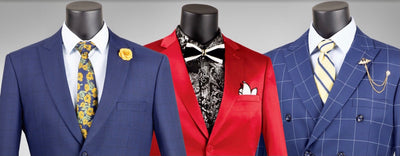Elevate Your Style with Men Suits Direct
Welcome to Men Suits Direct, your ultimate destination for high-quality men’s fashion. Whether you’re preparing for a wedding, a business meeting, or a special event, we have everything you need to look your best. Our extensive collection includes suits, shoes, hats, and accessories from top brands like Vinci, EJ Samuel, Statement Suits, and Milano Moda.
Discover Our Premium Suits
At Men Suits Direct, we offer a wide range of suits to cater to every style and occasion. Our collection features:
- Vinci Suits: Known for their modern designs and impeccable fit, Vinci suits are perfect for any formal event.
- EJ Samuel Suits: These high-fashion suits are crafted from premium fabrics, offering a sophisticated look for weddings, proms, and business meetings.
- Statement Suits: Make a bold impression with Statement Suits, designed to stand out with unique patterns and vibrant colors.
- Milano Moda: Combining classic elegance with contemporary style, Milano Moda suits are ideal for any occasion.
Complete Your Look with Stylish Accessories
No outfit is complete without the right accessories. At Men Suits Direct, we offer a variety of accessories to enhance your look:
- Dress Shoes: Our collection includes stylish and comfortable dress shoes that perfectly complement our suits.
- Hats: From classic fedoras to modern caps, our hats add a touch of sophistication to any outfit.
- Hat Bands: Customize your hat with our selection of hat bands, available in various colors and styles.
Perfect for Weddings and Group Orders
Planning a wedding or a group event? Men Suits Direct makes it easy to outfit your entire party. We offer special discounts for group orders, ensuring everyone looks their best without breaking the bank. Our expert staff is here to help you choose the perfect suits and accessories for your big day.
Why Choose Men Suits Direct?
- Quality and Affordability: We pride ourselves on offering high-quality fashion at competitive prices.
- Wide Selection: Our extensive collection ensures you’ll find the perfect suit for any occasion.
- Exceptional Customer Service: Our knowledgeable staff is dedicated to helping you find the perfect fit and style.
Shop Now
Visit Men Suits Direct today to explore our collection and elevate your style. Whether you’re shopping for a single suit or outfitting a group, we have everything you need to look your best.


 Single-breasted suit jackets and blazers typically have two or three buttons (jackets with one or four buttons exist, but are not common), and a notch lapel. However, from the 1930s onward, peaked lapels, often on a single button jacket, have been variably in fashion. The width of the lapels is one of the most changeable aspects of the jacket, and narrow peak lapels on single-breasted jackets became popular during the 2000s.
Single-breasted suit jackets and blazers typically have two or three buttons (jackets with one or four buttons exist, but are not common), and a notch lapel. However, from the 1930s onward, peaked lapels, often on a single button jacket, have been variably in fashion. The width of the lapels is one of the most changeable aspects of the jacket, and narrow peak lapels on single-breasted jackets became popular during the 2000s. Today, double-breasted jackets are not as popular in the USA, and it is difficult to find them at many retail clothing stores; however, they continue to be popular in the United Kingdom.
Today, double-breasted jackets are not as popular in the USA, and it is difficult to find them at many retail clothing stores; however, they continue to be popular in the United Kingdom. This is the standard on single-breasted suits, and is used on nearly all suit jackets, blazers, and sports jackets. The notched lapel double-breasted jacket is a rare setting. The size of the notch can vary, and a small notch is called fish mouth. This was the first type of lapel to appear.
This is the standard on single-breasted suits, and is used on nearly all suit jackets, blazers, and sports jackets. The notched lapel double-breasted jacket is a rare setting. The size of the notch can vary, and a small notch is called fish mouth. This was the first type of lapel to appear. (both single and double breasted). In the late 1920s and 1930s, the single breasted peaked lapel jacket was considered a very stylish design. The feature was carried into day clothing by the increasing popularity of the peaked dinner jacket. The ability to cut peak lapels properly on a single-breasted suit is one of the most challenging tailoring tasks, even for very experienced tailors.
(both single and double breasted). In the late 1920s and 1930s, the single breasted peaked lapel jacket was considered a very stylish design. The feature was carried into day clothing by the increasing popularity of the peaked dinner jacket. The ability to cut peak lapels properly on a single-breasted suit is one of the most challenging tailoring tasks, even for very experienced tailors. it is now most common on the dinner jacket or tuxedo. This similarly began as informal evening-wear, and was then made in both more and less formal versions, depending on the situation in which it was to be used. It is also commonly used on the mess jacket
it is now most common on the dinner jacket or tuxedo. This similarly began as informal evening-wear, and was then made in both more and less formal versions, depending on the situation in which it was to be used. It is also commonly used on the mess jacket